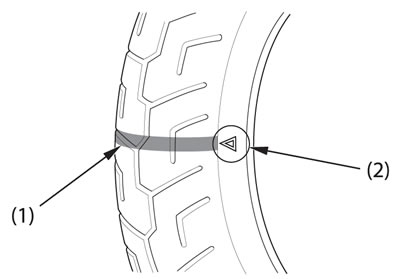The following pages provide more detailed information on how and when to check your tire pressure, how to check your tires for damage, and what to do if your tires need repair or replacement.
Attention!
- Operating your motorcycle with tires that are excessively worn or with improper tire pressure can cause an accident in which you may be seriously injured or killed.
- Follow all instructions in this manual regarding tire pressure maintenance and tire care.
Tire pressure
Correct tire pressure provides the best combination of handling, tread life and ride quality. Insufficient pressure leads to uneven tire tread wear and negatively affects handling. In addition, there is a danger of tires overheating and subsequent failure. Excessive tire pressure reduces ride quality, increases the likelihood of road damage, and causes uneven tire wear.
We recommend visually checking your tires before every ride and checking the tire pressure with a tire pressure gauge at least once a month or whenever you suspect your tire pressure has dropped. Tubeless tires have the property of self-sealing when punctured. However, since air leaks are often very slow, you must look for a puncture if the tire appears flat.
The pressure should always be checked on "cold" tires, when the motorcycle has been standing still for at least three hours.
If you check the pressure on hot tires after the motorcycle has been ridden for at least a few kilometers, the measured pressure will be higher than the pressure on the cold tires.
This is normal, so do not let the air out of the tires to set the recommended pressure for cold tires, the values of which are given below.
If you do this, your tire pressure will be lower than recommended.
Recommended pressure values for "cold" tires:
| kPa | ||
| Driver only | Front Rear | 225 225 |
| Driver and one passenger | Front Rear | 225 250 |
Tire check
Whenever you check tire pressure, you should inspect the tire tread and sidewalls for wear, damage, and foreign objects stuck in the tread.
Please note the following:
- Bulges or swellings on the tread or sidewalls of a tire. If a bulge or bulge is detected, the tire must be replaced.
- Cuts, tears or cracks in the tire. If cord fabric is visible in a crack or tear, the tire must be replaced.
- Excessive tread wear.
If you hit a pothole or hit a hard object, pull over to the side of the road as soon as possible and inspect your tires to make sure there is no damage.
Tread wear
The tire must be replaced before the tread depth at the center of the tire reaches the following limit:
| Minimum tread depth | |
| Front wheel: | 1.5 mm |
| Rear wheel: | 2.0 mm |
For Germany
German law prohibits the use of tires with a remaining tread depth of less than 1.6 mm.

(1) Wear indicator; (2) Wear indicator location mark
Tire repair
A damaged or punctured tire should be replaced without attempting to repair it. Below is an explanation of why a tire that has undergone a repair, either temporary or full repair, will have reduced speed limits and performance limits compared to a new tire.
Making a temporary repair, such as an outer plug for a tubeless tire, may not be safe to drive even at normal speeds and under normal road conditions. If a tire has undergone a temporary or emergency repair, you should drive slowly and carefully to an authorized dealer to have the tire replaced. If possible, do not carry a passenger or cargo until the tire is replaced with a new one.
Even a professionally repaired tire with an internal plug-patch will not have the same characteristics as a new one. When using such a tire, it is prohibited to exceed the speed of 80 km/h (50 mph) during the first 24 hours and 130 km/h (80 mph) the entire remaining period of operation. In addition, you will no longer be able to safely load the motorcycle to the same extent as with a new tire. Therefore, we strongly recommend replacing the damaged tire. If you decide to use a refurbished tire, be sure to balance it first.
Tire replacement
The tires installed on your motorcycle are designed to suit the performance of your motorcycle and provide the best combination of handling, braking performance, durability and comfort.
Attention!
- Installing non-recommended tires will result in poor handling and stability of the motorcycle. It may also cause an accident in which you could be seriously injured or killed.
- Always use tires of the size and type recommended in this Owner's Manual.
The following tires are recommended for your motorcycle:
- Front wheel: 130/70R18M/C 63H DUNLOP D251F
- Rear wheel: 180/70R16M/C77H DUNLOP D251
Each time you replace, use a tire equivalent to the original one and be sure to balance the wheel after installing a new tire.
Important Safety Information
Tubeless tires with tubes installed are prohibited on this motorcycle. Excessive heating of the tube during motorcycle operation may cause it to suddenly rupture.
Use only tubeless tires on this motorcycle. The wheel rims are designed to accommodate tubeless tires, and during heavy acceleration or braking, the tube type tire can spin on the rim, causing a sudden loss of tire pressure.
